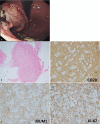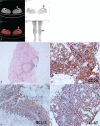Secondary skin involvement in gastric diffuse large B-cell lymphoma treated with chidamide: A case report
- PMID: 30544372
- PMCID: PMC6310597
- DOI: 10.1097/MD.0000000000013093
Secondary skin involvement in gastric diffuse large B-cell lymphoma treated with chidamide: A case report
Abstract
Rationale: Diffuse large B-cell lymphoma (DLBCL) is a neoplasm of large B lymphoid cells that exhibits diffuse growth patterns. Patients may present with nodal and/or extranodal disease. The most common extranodal site is the gastrointestinal tract, while skin is less common.
Patient concerns: We report a case of secondary skin involvement of an original gastric DLBCL, which has achieved a complete response after treatment with chidamide.
Diagnoses: Initially, the diagnosis of gastric DLBCL is clear, and this patient responded well to systemic chemotherapy (rituximab + cyclophosphamide + epirubicin + vincristine + prednisone) after 8 cycles. Thirty months later, some rapidly enlarging skin nodules on his arm were found. These skin nodules were diagnosed as secondary cutaneous DLBCL based on the clinical features, positron emission tomography-computed tomography, and histomorphologic and immunohistochemical expression.
Interventions: Steroids, interferon-α, and radiation had little therapeutic effect. We treated the patient with chidamide at 30 mg twice per week in combination with dexamethasone.
Outcomes: The skin nodules regressed 3 weeks later. During the 1-year follow-up period, the patient is still in treatment with chidamide without adverse reactions.
Lessons: To the best of our knowledge, this is the first case of secondary skin DLBCL reported to exhibit a complete response to chidamide, which provides a novel therapeutic strategy for secondary skin DLBCL. However, more cases are still needed to further validate its efficacy.
Conflict of interest statement
Authors declare no competing financial interests.
Figures




Similar articles
-
Treatment of refractory diffuse large B-cell lymphoma by chidamide combined with autologous stem cell transplantation: a case report.Anticancer Drugs. 2021 Sep 1;32(8):886-889. doi: 10.1097/CAD.0000000000001093. Anticancer Drugs. 2021. PMID: 34145178
-
Successful treatment with lenalidomide plus chidamide combination therapy in 3 heavily treated patients with non-Hodgkin lymphoma: Three cases report.Medicine (Baltimore). 2020 Oct 23;99(43):e22788. doi: 10.1097/MD.0000000000022788. Medicine (Baltimore). 2020. PMID: 33120793 Free PMC article.
-
Retrospective analysis of primary gastric diffuse large B cell lymphoma in the rituximab era: a multicenter study of 95 patients in Japan.Ann Hematol. 2012 Mar;91(3):383-90. doi: 10.1007/s00277-011-1306-0. Epub 2011 Aug 6. Ann Hematol. 2012. PMID: 21822617
-
Secondary cutaneous Epstein-Barr virus-associated diffuse large B-cell lymphoma in a patient with angioimmunoblastic T-cell lymphoma: a case report and review of literature.Diagn Pathol. 2012 Jan 19;7:7. doi: 10.1186/1746-1596-7-7. Diagn Pathol. 2012. PMID: 22260632 Free PMC article. Review.
-
Therapeutic effect of chidamide on relapsed refractory angioimmunoblastic T-cell lymphoma: A case report and literature review.Medicine (Baltimore). 2018 Jan;97(2):e9611. doi: 10.1097/MD.0000000000009611. Medicine (Baltimore). 2018. PMID: 29480865 Free PMC article. Review.
Cited by
-
Diffuse Large B Cell Lymphoma with Cutaneous and Gastrointestinal Involvement.Case Rep Gastrointest Med. 2022 Feb 27;2022:2687291. doi: 10.1155/2022/2687291. eCollection 2022. Case Rep Gastrointest Med. 2022. PMID: 35265383 Free PMC article.
-
Two secondary localisation of non-Hodgkin's lymphomas in the upper gastrointestinal tract.BMJ Case Rep. 2022 May 18;15(5):e247607. doi: 10.1136/bcr-2021-247607. BMJ Case Rep. 2022. PMID: 35584861 Free PMC article.
-
Recent Advances in the Targeting of Epigenetic Regulators in B-Cell Non-Hodgkin Lymphoma.Front Genet. 2019 Oct 16;10:986. doi: 10.3389/fgene.2019.00986. eCollection 2019. Front Genet. 2019. PMID: 31681423 Free PMC article. Review.
References
-
- The Non-Hodgkin's Lymphoma Classification Project A clinical evaluation of the International Lymphoma Study Group classification of non-Hodgkin's lymphoma. Blood 1997;89:3909–18. - PubMed
-
- Armitage JO, Weisenburger DD. New approach to classifying non-Hodgkin's lymphomas: clinical features of the major histologic subtypes. Non-Hodgkin's Lymphoma Classification Project. J Clin Oncol 1998;16:2780–95. - PubMed
-
- Harris NL, Jaffe ES, Stein H, et al. A revised European-American classification of lymphoid neoplasms: a proposal from the International Lymphoma Study Group. Blood 1994;84:1361–92. - PubMed
-
- Castillo JJ, Winer ES, Olszewski AJ. Sites of extranodal involvement are prognostic in patients with diffuse large B-cell lymphoma in the rituximab era: an analysis of the surveillance, epidemiology, and end results database. Am J Hematol 2014;89:310–4. - PubMed
-
- Lee WJ, Won KH, Won CH, et al. Secondary cutaneous diffuse large B-cell lymphoma has a higher international prognostic index score and worse prognosis than diffuse large B-cell lymphoma, leg type. Acta Derm Venereol 2016;96:245–50. - PubMed
Publication types
MeSH terms
Substances
Supplementary concepts
LinkOut - more resources
Full Text Sources
Medical

